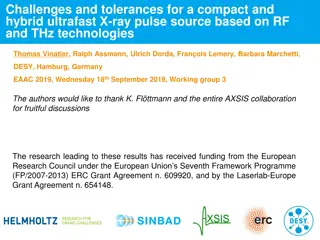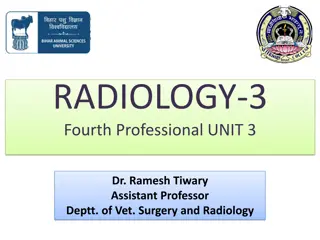Understanding X-Ray Film Processing Techniques
When a beam of photons exposes an X-ray film, it chemically alters the silver halide crystals, creating a latent image. Film processing involves developer, fixer, and a series of steps to convert the latent image into a visible radiographic image. The developer reduces silver ions in exposed crystals to metallic silver grains, enhancing image density. The developing solution contains components like reducing agents, activator, restrainer, and preservative. After development, rinsing the film dilutes the developer and prepares it for fixing.
Download Presentation

Please find below an Image/Link to download the presentation.
The content on the website is provided AS IS for your information and personal use only. It may not be sold, licensed, or shared on other websites without obtaining consent from the author. Download presentation by click this link. If you encounter any issues during the download, it is possible that the publisher has removed the file from their server.
E N D
Presentation Transcript
When a beam of photons exits an object and exposes an x-ray film, it chemically changes the photosensitive silver halide crystals in the film emulsion. These chemically altered silver bromide constitute the latent image (invisible) on the film. Exposure to radiation chemically alters the photosensitive silver halide crystals to produce the latent image .Processing developer and fixer convert the latent image into the visible radiographic image . .Processing the exposed film in
Film processing involves the following procedures : 1- Immerse exposed film in developer 2-Rinse film in water bath 3-Immerse film in fixer 4-Wash film in water bath 5-Dry film
The developer reduce all silver ions in the exposed crystals of silver halide (those with a latent image ) to metallic silver grains . Areas with many exposed crystals are denser because of their higher concentration of black metallic silver grains after development .If the developer remains too long in contact with silver bromide halide crystals that do not contain a latent image , it slowly reduces these crystals also , thereby overdeveloping the image .
The developing solution contains four component , all dissolved in water: Developer or reducing agents Convert the exposed silver halide crystals to black ,metallic silver grains. Developer or reducing agents Activator or accelerator It softens and swells the emulsion so that the developing agents can reach the crystals more effectively , it also provides the necessary alkaline environment for the developing agents. Restrainer Prevent the developer from developing unexposed crystals and keep the image from appearing fogged ( dull , gray ,and lacking in contrast ). Activator or accelerator : Restrainer:
. Preservative Prevents oxidation of the reducing agents in the developer in order to prolong the effectiveness of the chemicals . Preservative : :
After development , the film emulsion swell and becomes saturated with developer . At this point the film are rinsed in water for 30 seconds before they are placed in the fixer . Rinsing dilutes the developer , slowing the development process . It also removes the alkali activator , preventing neutralization of the acid fixer . This rinsing process is typical for manual processing but is not used with automatic processing .
Fixing solution The primary function of fixing solution is to dissolve and remove the undeveloped silver halide crystals from the emulsion . The presence of unexposed crystals causes film to be dark . A second function of fixing solution is to harden and shrink the film emulsion. Fixing solution
Fixing solution also contains four components : Fixing or clearing agent It remove (by dissolving ) unexposed , undeveloped silver halide crystals from the emulsion Acidifier Helps to terminate the developing process by neutralizing the alkaline developer . It also provides the necessary acid environment required by the fixing agent. Hardener Shrink and hardens the emulsion after it has been softened by the activator in the developing solution . Preservative Prevent chemical deterioration of fixing solution Fixing or clearing agent : Acidifier : Hardener : Preservative
Washing A washing step is necessary to remove all excess chemicals from the emulsion . Washing
Is the area which the films must be process , because radiographic film is sensitive to visible light , so processing must be conducted in an area of relative darkness.
It depends on ; 1- Types& amount of the films to be processed . 2- Number of persons working in the darkroom ( if one person works in the darkroom , 9x9 feet is recommended to process dental radiograph ,while 20x20 feet of floor space is recommended for more than one person .
1- It should be located in the cool part of the office ,since the best processing is achieved at 68 f , and the film should be stored in a cool place 2- It should be approachable from the rooms where the films are to be exposed and examined . 3- The temperature of the room should fluctuate as little as possible , since the temperature of the processing solution must be kept constant . 4- Consideration should be given to the humidity ,since extreme humidity retards drying of the processed films , and damages unused films stored in open boxes , while low humidity can cause static electricity problem
1- Light tight room through the use of a maze or a light tight door . 2- The surface of the room should be able to resist chemicals of processing . The floor should be waxed to be protect from chemicals and wall colors should be light enough to reflect the safe light . 3- The illumination of the darkroom is consists of two types a)Ordinary white b)Safe light :
It is a low intensity light composed of long wavelength in the red orange portion of the visible light spectrum . Safe light provides sufficient illumination in the darkroom to carry out processing activities safely without exposing or damaging the film A safe light lamps are equipped with filters that eliminate the portion of visible light spectrum to which the film most sensitive especially the green & blue wave length ,that are responsible for exposing and damaging x- ray films .The filters allow the passage the orange & red end of the spectrum .
A safe light typically consists of a lamp equipped with a low wattage bulb ( 7 1\2 or 15 watts ). It must be placed a minimum of 4 feet (1.2 meters )away from the film and working area . The working time under safe light condition should be short (5min )since prolong exposure of film to safe light will result in fog film .
1-Turn off all lights including the safe light and wait a maximum of 5 min to obtain a fair degree of adaptation to eyes ,than look for any place where light is getting into the room from the outside , these light leaks should be obliterated . 2-Penny test : A small coin is placed on the film and the safe light is turn on , then the film is left for a length of time equal to the time that any unwrapped film of this type can be left before processed , then the film is process .If the image or the outline of the coin can be seen, the darkroom is not safe and the safelight should be rectified .
1 1- - Manual It is a simple method that is used to : develop , rinse , fix ,and wash dental x- ray films . The essential piece of equipment required for manual processing is a processing tank Processing tank : is a container divided into compartments to hold the developer solution , water bath ,and fixer solution . A processing tank has two insert tank and one master tank . Manual or wet processing : wet processing : processing tank
After developing , the film is rinsed in running water ,then the film is put in the fixer solution . If the film is left long in the fixer some of the silver that forms the image will be removed & the radiograph will loss density . To remove the fixing solution , the film must be washed in running water ,otherwise the film become discolored by time . The temperature of the solution should not vary greatly ,if the film emulsion is subjected to quick change in temperature from warm to cold, the emulsion
contract &form a lace like pattern called reticulation from cold to warm ,it is not harmful except that excessively warm solution cause the emulsion to melt . After washing , the film is dried in a dust free area before mounting . reticulation ,but if the film emulsion passing
It is constructed with a transport system that consist of a series of rollers driven by a constant speed motor operating via gears ,belts or chains Function of the rollers in the automatic processor : 1- film transport 2- massage &uniformly distribute the chemical over the film . 3- act as a squeegee which removes the chemicals & water from the film emulsion .
Rollers are designed to rotate at a speed compatible with the temperature of the developer solution .Thus , the speed of the roller as well as the processing time can be adjusted by altering the temperature of the developing solution . Time & temperature are inversely proportional
It is alternative to manual processing . The x- ray film is presented in a special sachet containing developer & fixer . Following exposure , the developer tab is pulled , releasing developer solution which marked down toward the film & massaged around it .After 15 sec .,the fixer tab is pulled to release the fixer solution down to the film . After fixing , the used chemicals are discarded and the film is rinsed thoroughly under running water for about 10 min.

























